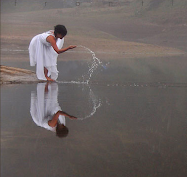Film Review of Busong
Mykelle Pacquing
Oct. 27, 2011
I recently watched Aureaus Solito’s latest film Busong (translated from Palawan as “fate”) at the ImagineNative film festival in Toronto. I have never seen any of Solito’s work prior to Busong. As well, all I knew of him was of what Katrin de Guia mentioned of him in her article contribution to Babaylan: Filipinos and the Call of the Indigenous. I called on some of my family to attend the film and it happened that my Tita and my two cousins—her two children—came with me.
After the film, I felt overwhelmed—the film was intense. I felt that my thoughts had been catapulted into the mountains, rivers, beaches, forests of Palawan (as the north wind began to bring in the cold weather outside the theatre)—as well as the challenges, realities, beauties, and gifts that the Palawan people bring in their spirituality and worldview that is so intrinsically tied to the land. The implications of watching the film in Toronto at an Indigenous film festival which brought people of all colours to see the film had given me great comfort and hope for peace and understanding on this land. It was the first time for me that friends from my Indigenous circles and my Filipino circles had come together on equal footing—we are beginning to see the interconnections of our stories.
Oftentimes I get the sense that the Indigenous People of the land where I’ve made my home feel alienated from the peoples who arrive to their traditional lands because of the waves of colonization that have been pouring in from all over the world carrying their traumas and diseases—making them feel weary of the cultures that newcomers bring with them. On the Filipino side, I get the sense that many Filipinos that live away from the Philippines believe that they are severed from their homeland and have no choice but to assimilate to the dominant culture in order to flourish—and with that that, the assimilation of the dominant culture’s behavior of suppressing Indigenous People. It was for the first time that I felt that the two communities were open to each other.
Despite my education in Indigenous ways, I could sense at the beginning of the film—when the viewer is forced into the Palawan pace of time in long drawn-out shots of the landscape—that my impatience with this pace revealed my modern city indoctrination. At this point of the film, I had to let go of this need to process my thoughts as fast as I could simply for the sake of efficiency. I had to let go of my city-mind—needed to navigate train lines, schedules and coordinate meeting places and pick-up locations—and suspend them to immerse myself into the film. There caused a mental discomfort, but it felt like medicine afterwards. It was necessary in order to see the film at the level that Solito presented.
After the first sub-plot, it began to make sense how Solito was exposing the interconnections of the stories—the search for healing and for beauty—in the Palawan way. It became clear how the struggle for that beauty is brought about by going through forced external interferences—a chainsaw that was used to cut indiscriminately, a white foreigner who imposed alien concepts of private property, and a Manilan who finds his Palawan spirit name and takes up his role as a balian. The ending of the film encompasses all these struggles and the beauty that was borne from all the separate stories.
I was saddened that my younger cousin did not understand the film, but this reminded me that understanding Indigenous ways is a privilege. Indigenous ways are not relegated to the marginalized, the uneducated, the illiterate, and the economically disadvantaged as mainstream perception perceives it. It takes a fair amount of experiential education and literacy of nature simply to understand Solito’s film—and I think this is one of the film’s weaknesses. The reality is, if you grew up in the city in a Christian family, the richness of what Busong offers may not be accessible to you.
What concerns me now is not so much if Busong can be understood in its film context, so much as if the Indigenous Thought implicated in the movie can still be accessed by non-Palawan city dwellers in a real-world context. Can the concept of busong—as I understand it, the understanding of one’s story, which encompasses one’s fate (or what the Creator provides you), experiences, and actions—be understood and integrated into one’s worldview? Can the intrinsic connection to spirit and the land be understood as crucial in maintaining balance in one’s life? Can the innocence of a lifestyle gathering clams provide a shift in the modern consciousness that has been conditioned and industrialized to work the body full-time?
Solito’s film would say that yes, that this can be done—as depicted by the Palawan who was born and raised in Manila and became immersed in his ancestors’ ways out of his desire to go back to Palawan and hear the ending of his uncle’s song that he recorded some time ago.
It is my hope that this film fuels the desire of others to find the songs of their own busong and sing them, knowing that wherever they are, the land is listening.







